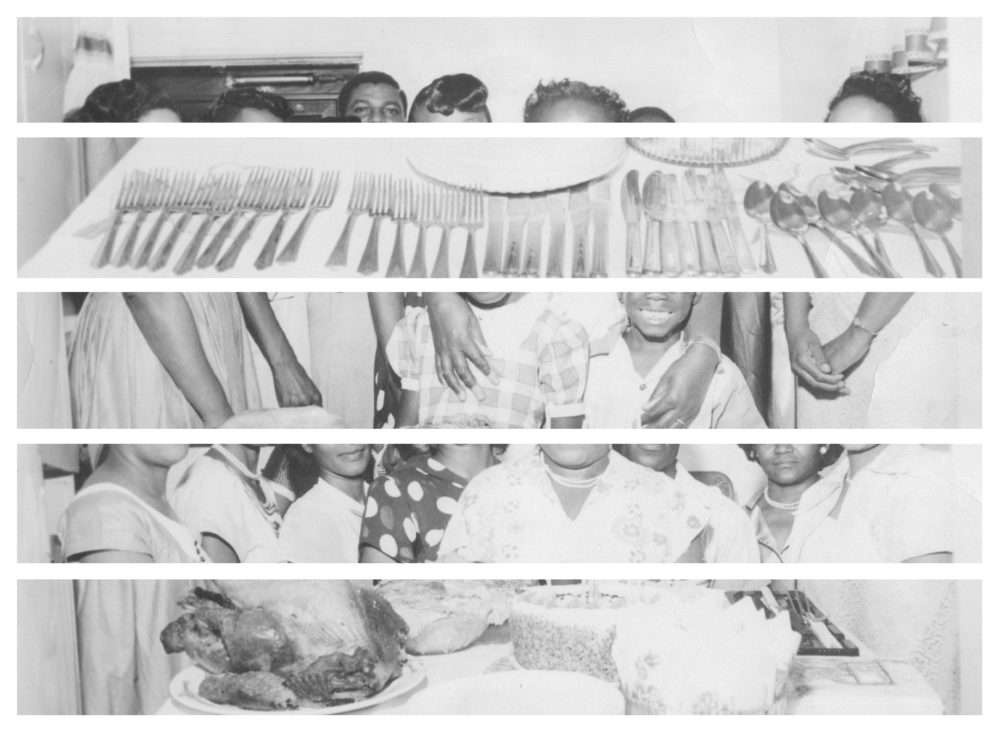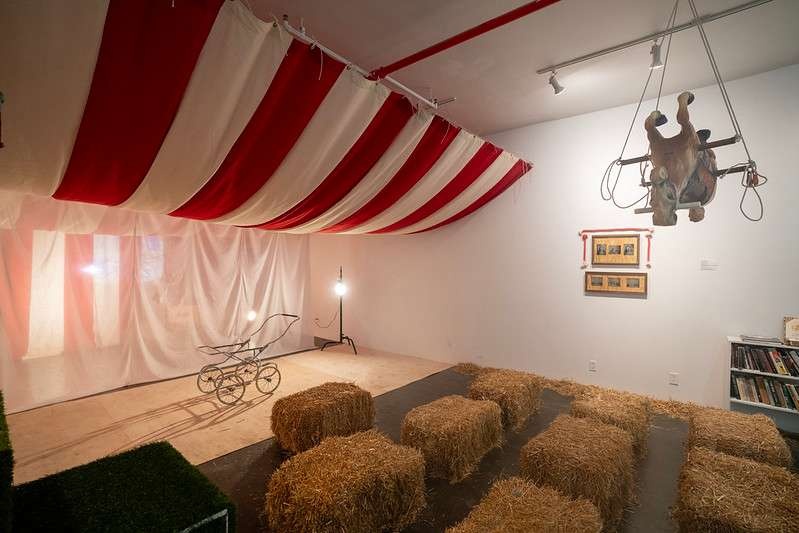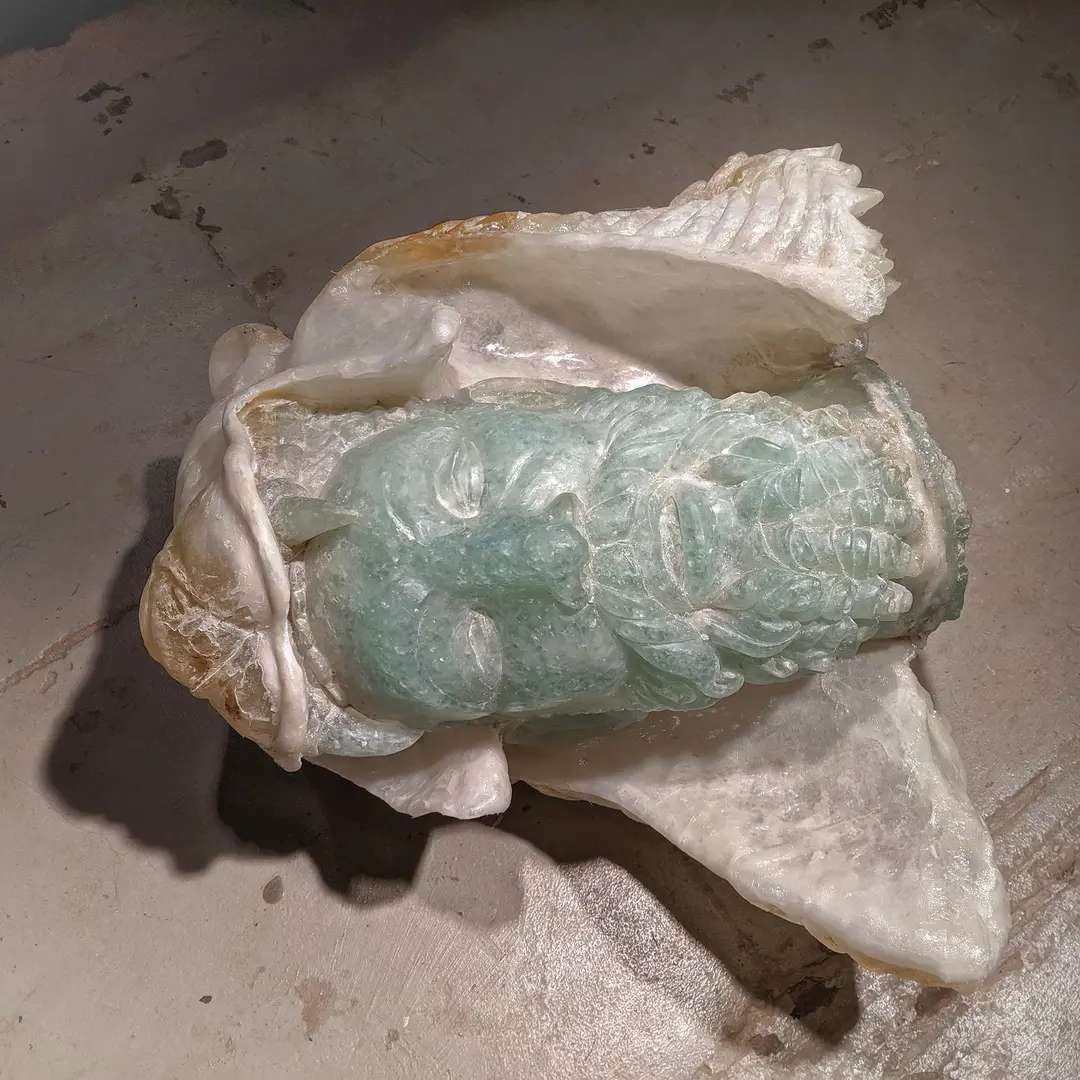This world might crack. Its insides could very well spill out, divulging unknown delights. In the wrinkles of its withered hull one may discover a traceable history—a kind of infallible memory made somehow reachable by way of our own unraveling.
I once misremembered a story my Papa told me in a string of accounts outlining our family history. Per my remembrance, my late grandfather, Mr. Hopkins, was offered a faculty position at a university in Chicago. (What little I knew of him at this point had always suggested that he spent most of his adult life as a Seng Co. factory laborer manufacturing metal parts for home furniture.) Papa alluded to my grandfather’s talents, his hitherto unmentioned brilliance, some redemptive possibility for a man whose children had held him in low regard. When my grandfather arrived in Chicago and the institution’s administrators discovered that this would-be employee was a black man, his position was denied. As redress, the university offered him a janitorial role. This was the assumed origin story of our family’s life in the Midwest, birthed from a tale of loss in Chicago and my grandparents’ eventual relocation to Gary, Indiana. While of the same bloodline, the blood of my grandfather existed, to me, only within the margins of the stories shared about him.
The details of Papa’s story were unstable, at best. And when I finally questioned its inconsistencies on a phone call with my aunt, the eldest of my grandparents’ children, she settled my uncertainty: “That is a story I have never heard and it is highly implausible that [the university] would offer anyone a job sight unseen, especially a graduate from an undistinguished HBCU.” Papa later denied making this claim at all, insisting instead that this anecdote was actually a parable, never a true fragment of our history. What I had recalled as a point of pride, an isolated gesture of admiration for our family patriarch, was instead revealed as my embarrassing transgression of remembering our lineage—nothing more than my Papa’s half-successful lesson on the black American condition, black grief. Ours was a conflict of memory wherein we tried to construct an explanation for instances of small, compounded loss; a kind of loss that is otherwise excruciating to accept as possibly ordinary, undistinguished.
Yet, as a result of my misremembering Papa’s story, my grandfather and his blood as such gained a temporary richness that I wondered if we might all inherit. For a moment, I understood why one might seek to savor our blood a symbol of an ancestry worth savoring. A story, a man, eaten up in life and death.
What is it to be delectable? To be devoured as a delicious thing? And how might one conceive of an expression for this experience? I suspect that Mr. Hopkins’ story held these questions in consideration. The ability to create something different of our history, transform an old idea, or to achieve some small victory over representation could read as road signs to a material existence. Certainly, all are irresistible alternatives to the possibility that one’s “being” might correspond with “being consumed.” These are tokens of humanity, without which life and history become questions of survival, conflicts of memory, devoid even of the recognition that one necessarily began alive.
If given a voice in his own telling, my grandfather might ask: what makes me so appetizing? And what of this body politic that regards my blackness as, at once, tempting and despicable 1? These questions must also be directed toward a larger history, a national lineage around which it seems so difficult to form a cohesive memory—if only to confront our crises of survival as we dodge this history’s next crushing bites. Preserving a sense of humanity under such conditions is much like contending with the challenge of explaining a flavor without the words sweet, salty, bitter. But still, one has many ways of living without the guarantee of survival’s favored tools. Through the phenomenon of repetition (of continued creating) we find new tools to escape obliteration, to remember.
We may retell a narrative, or appropriate a familiar symbol, idea; lick our fingers for the last crumbs of evidence that we are, in fact, here. My grandfather’s story may be a case of my errant memory, or perhaps it was my Papa’s unsteady narrative. But in collectively establishing a space for that story to exist, I also sense our search for an explanation; negotiating for any kind of existence counter to the generalized, supposed inhumanity of blackness. Distinguished enough within the context of American life so as to be indistinguishable from it. So irresistible, and this time at least by our making, that we might understand why one would venture to take a bite.
In Kiyan Williams we see the juncture of these questions of narrative, consumption, blackness and memory. Like language, icons tend to fall short—they are at most halfway present, echoes, signs without a discernable reference point. (I would argue that they are more spectral than not; we are the ones that nourish their concept.) Still they persist. An icon, such as a flag, is malleable, able to be re-contextualized, perhaps best defined by its engagement with new contexts. And in the slippery process of locating an icon’s meaning, one might begin to wonder if its significance is most coherent in this process of searching for meaning itself; like reflecting on the symbol of a ghostly relative or a false family story, not for its content but for the purpose of its telling.


Archival Image, Birthday Party at 2175, Jumbled, (early 1950’s).
Black and white family dinner photo, cut and re-arranged in narrow horizontal strips with white space in between.
Within their session, something else (Variations on Americana), Williams creates culinary manipulations of American cultural icons: a U.S. flag fry, a pig roast embellished with police uniforms. Less concerned with defining “American-ness” alongside blackness, through their use of symbolic objects, they detect an American-ness inextricable from blackness. In frying the flag, Williams becomes entangled in this icon’s making (the creation of something new, the unmaking of an old symbol) and through this process, they call attention to the dynamics of consumption shaping the American State and black life. Resonating with a grave and almost absurdist humor, Williams makes a literal and metaphorical meal on which we can dine. Williams serves symbols of the American experience as one whose survival has always relied on its hunger for blackness, seasoned with the culinary rituals of the diaspora. An infinity loop—a repast that never ends. The paradoxical consumption of black America indicating the devouring of America itself.
Something about these symbols of Americana claim to be universal. The assertion: that the American experience is one of uniformity, functioning to claim everything under its domain while simultaneously denying the ontological subjugation of its black people 2. Other iterations of this icon work have come before (David Hammons, Dread Scott, Faith Ringgold, Pope.L, and others) but this repetition and the inadequacy of our conceptual systems for digesting it makes our bellies ache. With this black life on which others incessantly feed, ravaged by a near-spiritual, philosophical hunger, what can one do but reach towards a new thing? In what seems an infinite loop, Williams reminds us once again of the phenomenon of repetition, of remembering, and of ways to transform away from obliteration: community recipes, ways of gathering, manipulating familiar symbols, (mis)remembering family stories, always with the potential to send seismic ruptures through the foundation of an “American” experience. Our world could crack. Its sumptuous innards may ooze through these rifts—morsels that were once consumed flowing outwards to a something else.
References
[1] Vincent Woodard poses a similar, if more detailed inquiry, suggesting “When black Americans described instances of the eating, cooking, and consumption of flesh in slave narratives, newspaper articles, speeches, testimonials, sermons, and autobiographies, they not only questioned the national body politic but also tried to understand why and how they had become so delectable, so erotically appetizing, to a nation and white populace that, at least rhetorically, denied and despised their humanity” (23). See, Vincent Woodard, The Delectable Negro: Human Consumption and Homoeroticism Within US Slave Culture (New York: NYU Press, 2014).
[2] Fred Moten asserts that “blackness and ontology are unavailable for one another; on the other hand blackness must free itself from ontological expectation, must refuse subjection to ontology’s sanction against the very idea of black subjectivity” (749). Fred Moten, “Blackness and Nothingness (Mysticism in the Flesh),” South Atlantic Quarterly 112, no. 4 (2013): 737-780.
About the artist
Sami Hopkins
Sami Hopkins is an artist, musician, and writer based in Queens, NY. She is an alumna of the Studio Museum in Harlem’s Museum Education Practicum (Fall 2019 cohort) and an upcoming 2021 Suzanne Fiol Curatorial Fellow at Issue Project Room. Her most recent writing can be found in Studio Magazine.
Projects
Explore/Archive
See allOctober 2025
streamlined reflections, courtesy of noise canceling headphones
Gabrielle Rucker
Gabrielle Rucker reflects on the radical intimacy and auditory life at the heart of Deli Radio
July 2025
Tell My Jockey: CUNTRY’s Discourse From the Horse’s Mouth
Ericka Pérez
Assembly fellow Ericka Pérez reflects on clowning, resistance, and CUNTRY’s radical refusal to perform.
April 2025
The Second Head of Hercules: Art and Resistance Through Four Years of Upheaval
Shakeem Floyd
written in conjunction with artist Onyedike Chuke's Session x Assembly project, The Forever Museum Archive: Circa 2020_An Object





